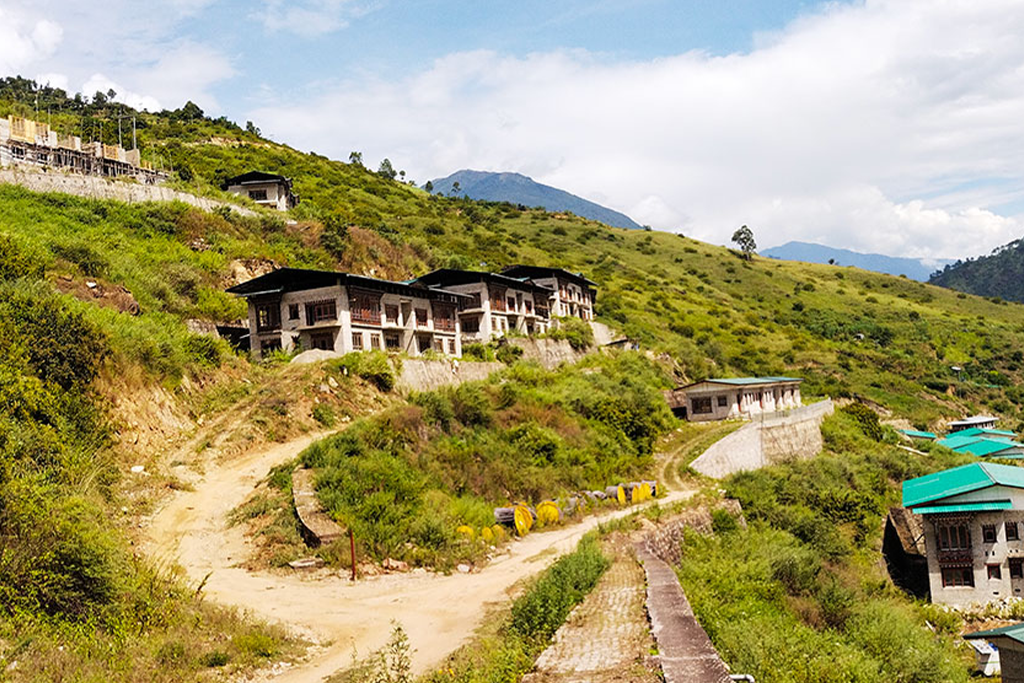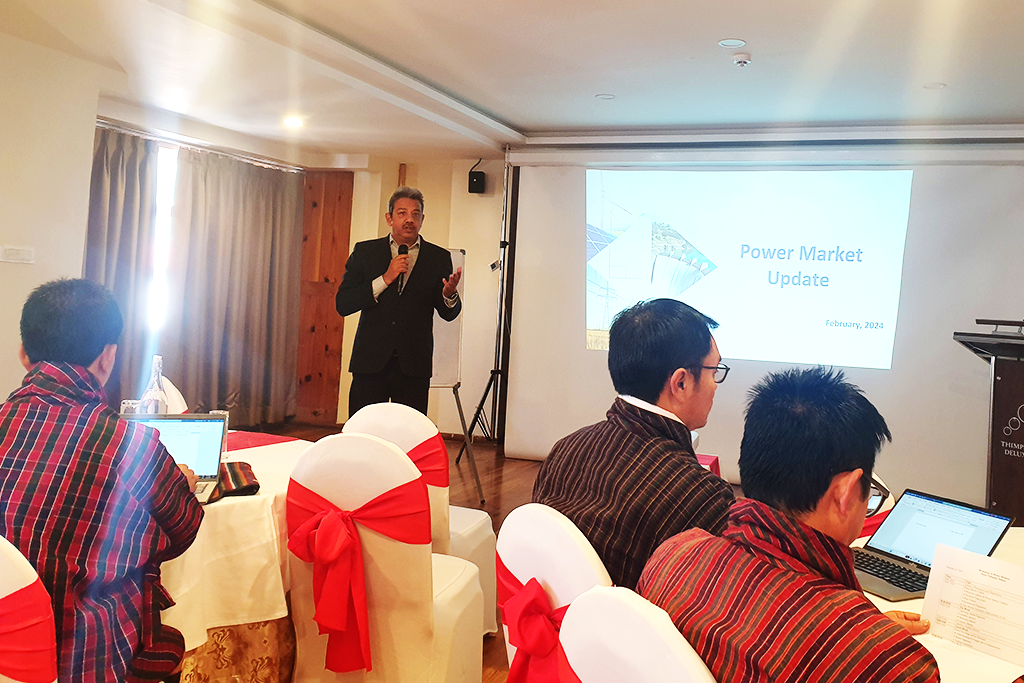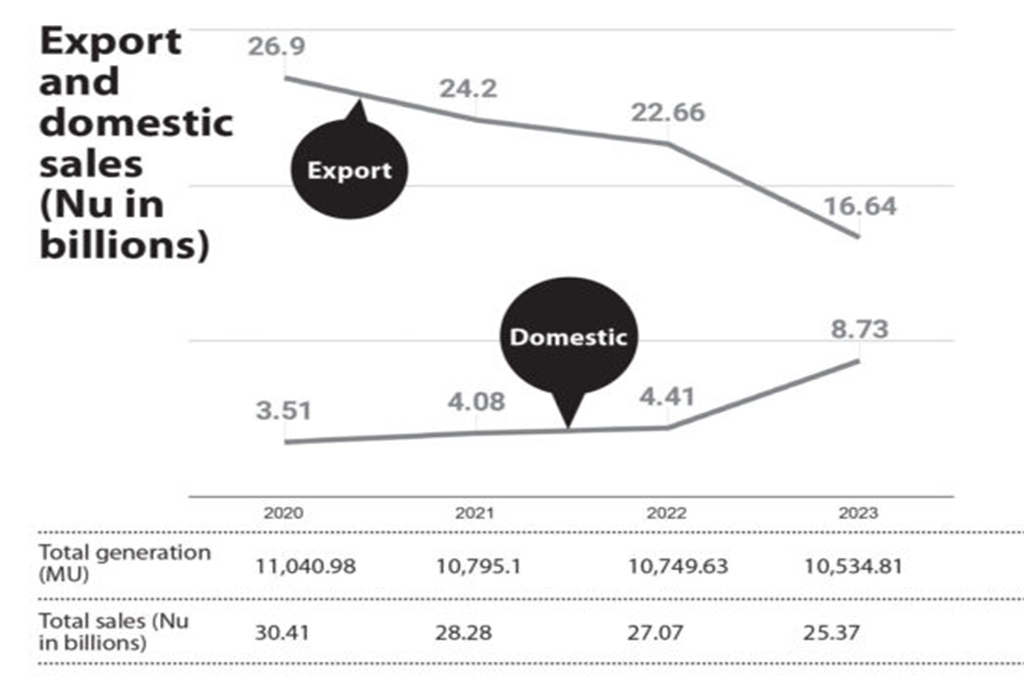The Bhutanese | Tenzing Lamsang | December 23, 2023
His Majesty The King outlined that one of the three priority areas to support the Gelephu project will be the energy sector including solar, wind, geo thermal and hydropower.
Following this, the Druk Green Power Corporation (DGPC) will be updating the DPRs of many of the many hydro projects and then look at raising funds and implementing them.
Kholongchu
The one that can be done the fastest among them is the 600 MW Kholongchu project as it has already built Nu 4.626 billion (bn) worth of initial infrastructure like roads, power facilities, and residential and non-residential structures needed for the project.
The former MoEA Minister Loknath Sharma had announced that the project would start construction by mid 2023 after securing funding from Power Finance Corporation (PFC) and the Rural Electrification Corporation (REC) which are both Public Sector Undertakings of India and fund power projects. However, funds have not yet been secured.
The Managing Director of the DGPC Dasho Chhewang Rinzin said the senior management team of PFC and REC are in Bhutan and detailed discussions are going on with them. He said the Government of India (GoI) is fully supportive in availing money.
Dasho said that the funding should be secured in the next two to three months.
The total project cost is Nu 60 bn of which Nu 4.626 bn is already spent leaving around 56 bn to be raised. The funding of the project will have to be 70 percent debt and 30 percent equity. The loan that will be taken from the PFC and REC will be around 40 bn and DGPC will have to raise around Nu 16 to Nu 17 bn as equity.
This equity will be raised from DGPC’s cash flow, NPPF and local banks.
The deal has not reached closure on financing yet and the most important thing for DGPC will be coming up with equity financing. The PFC and REC will also want securities or collateral which will be the project assets itself. The deal has not yet reached the stage to discuss the loan interest rates.
The interest rates will depend in part on repayment capacity and on that the DGPC has a good track record with the GoI in bilateral projects.
Once the financing is clinched then the MD said the project can go on in full swing and it can be completed in five years by around 2028.
The project started as a joint venture with with Satluj Jal Vidyut Nigam (SJVN) Limited but due to management, financing and implementation differences DGPC regained full ownership by repurchasing SJVN’s shares in early 2023.
Dorjilung
The other next big project is the 1,125 MW Dorjilung project. Here the DGPC MD said they are in the process of updating the DPR which should be done by around March or April 2024.
Once the DPR is done then they will get into discussions on financing and the deadline is to secure all the funding by the end of 2024, after which the project will take around 5 to 6 years to complete.
The government earlier this year had written a formal letter to the World Bank asking them to look for the funding of Dorjilung project through consortium financing.
The WB is already in talks with the European Investment Bank (EIB) and could bring in the Asian Development Bank too.
The last estimated cost of the project was put at Nu 74 bn, but the latest estimate could be USD 1.2 to USD 1.3 billion.
The project was initially proposed as a trilateral project between Bhutan, Bangladesh and India with Bhutan building the project with Bangladesh financing and exporting the power to them via India, but while Bhutan and Bangladesh agreed there was no response from India.
Bunakha, Wangchu and Chamkarchu
An interesting project is the 180 MW Bunakha reservoir project which would be able to store water for winter and also help the downstream projects of 336 MW Chukha, 1,020 MW Tala and 570 or 900 MW Wangchu.
The DPR has already been done but is being updated. The project will have a 180-meter-long dam.
The project was supposed to cost Nu 29 bn in around 2014 but the revised DPR will show a much higher cost now given inflation.
This project was initially listed as a JV to be done with SJVN under the 10,000 MW by 2020 but again funding and other differences led to separate ways.
Back in 2014 because of Bunakha, Chukha would gain an additional Nu 575 mn in revenue a year, Tala would gain Nu 972 mn a year and Wangchu would gain Nu 420 mn (at 2014 Chukha tariff rates).
A related and interesting project is the Wangchu project which will be down stream of Tala. Here the DGPC has two options.
One option is doing it as a run of the river project which is a 570 MW project at around nu 40 bn back in 2014.
However, the other option is to do it as a reservoir project that will store water for the winter months and this would be a 900 MW project.
The DGPC MD said they are now exploring this reservoir option given the changes in the energy market in India and they are also studying the costs and opportunities.
A project for which the DGPC has done the DPR is the 442 MW Nyera-Amari project. The project is on the Nyera Amari river that flow down from Merak-Sakteng, into Bangtar, Pemathang and Martshala.
The first stage of the project will be near Trashigang and the second stage in Martshala in Samdrupjongkhar.
The project cost is Nu 34.78 bn back in 2014.
The DGPC will also update the DPR of the 770 MW Chamkarchu project and see how it can be taken forward.
Chamkarchu and Wangchu were both listed as JV projects under 10,000 MW by 2020 but could not happen due to differences on the JV model between companies.
The DGPC MD said that the above projects are based in the Power System Masterplan where they are ranked higher and are the better projects and so their DPR was done and they can be taken up earlier.
Sunkosh
The biggest of all the projects is the 2,560 MW Sunkosh project. However, since the Sunkosh project comes under the larger Gelephu Mindfulness City, project there are not yet details on how the project will be taken up.
The project is estimated to cost well north of Nu 200 bn and will be a major reservoir project with tremendous potential to not only generate power, but ensure storage and generation in the winter months.
The project was in discussion in the past between Bhutan and India but got stuck due to implementation modalities and funding challenges.
So far, a press release talking about the aesthetics of the dam says the final bridge, will be hydroelectric dam, constructed on the city’s western border with a step-well retaining wall that offers viewpoints, staircases for meditative walks, and a temple. Visitors and pilgrims can ascend and descend along countless individual routes to the visitor center and temple nested on the face of the manmade cliff.
It says the Sunkosh Temple-Dam embodies in architectural form all the foundational elements of Gelephu: the harmonious coexistence of culture and nature, conceived as a hybrid child of Bhutan’s rich past heritage and its prosperous future legacy.
P II, P I, Nikachu, Solar and Wind
The DGPC MD said they will have to get going and the next one year will be taken up updating the DPR of the projects to factor in higher costs and any changes in the environment like changes in the river or river flow.
Earlier, in the 10,000 MW by 2020 GoI funding backed many of these projects but they did not happen and so a major challenge for Bhutan will be on how it secures billions in funding for these mega projects.
When comes to solar the DGPC MD said that the plan is to have 1,000 MW in solar power by 2030 by building small plants of 20 to 50 MW across the country. He said it cannot be done in a large way in one place.
On wind energy, some windfarms are possible but not at a large scale as many valleys in Bhutan do not have consistent wind.
DGPC is also doing at the possibility of doing geothermal energy in the longer term and here it will have to look at hot springs and other areas to do an assessment and see the options.
The DGPC MD said that the 118 MW Nikachu project will be done by the end of December or in January 2024. He said the project is funded by loans from the ADB and State Bank of India.
The Punatsangchu II project is making progress and is on track to be completed by mid 2024.
When it comes to the Punatsangchu I project the DGPC MD said that additional investigations are being carried out on the right bank and based on that the data will be studied by the experts.










